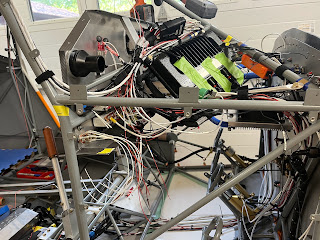We had sent our fuel pumps to Lockwood Aviation Services due to a Rotax Service Bulletin. The pumps were turned serviced and sent back to use rather quickly. Once received the pumps were remounted in their stainless steel case. The mount to the fuselage was reworked to make it easier to service the fuel pumps in the future. It is also a much cleaner installation.
 |
| Fuel Pumps received from Lockwood |
We decided to install two pass-throughs in our gear tunnel for electrical cables to run from the rear of the fuselage into the cabin area. Two plastic reinforcement rings were made and glued to the front and rear tunnel walls. A piece of SuperFlite fabric was glued on top of the reinforcement rings and allowed to dry. The area was repainted with gray primer. The four holes were cut out and grommets were installed. The grommets are there to keep cold outside air from entering in the cabin. Finally two plastic tubes were installed, thus allowing wires to pass through.
 |
| SuperFlite Fabric over Reinforcement Plate |
 |
| Grommets install (Baggage side) |
 |
| Grommet and Plastic Tube installed (Cabin side) |
We purchased an EarthX ETX-900VNT (vented) battery along with a matching battery box/holder. The battery box was mounted to the battery tray provided by Just Aircraft with 8 flush mounted solid rivets in the base of the battery box. The battery contactor was installed on the battery tray just forward of the battery box using AN4 bolts. An 4 AWG was run from the battery to the contactor as well as from the contactor to the starter solenoid running through the recently installed pass-throughs.
 |
| Battery box and contactor installed |
 |
| Battery installed in battery box |
 |
| 4 AWG wire being installed to Starter |
A ground bus block was purchased from SteinAir and mounted to the firewall in the cabin. On the engine side, the engine block and airframe ground on the Rotax Fusebox were grounded to the ground bus block via the passthrough bolt. The engine block was grounded since it is the return path for the starter. A 4AWG wire was routed from the ground bus block though the cabin pass-throughs to the battery in the aft fuselage.
 |
| SteinAir ground bus block |
 |
| Engine block and Fuseblock grounded |
The Garmin GSB15 USB charger was wired with power and ground. A third wire was run to turn off the internal LED by grounding it. Looks like our GSB15 unit is defective as the LED's would not illuminate with the cable open or grounded. Not as issue since we wanted the LED's off anyway.
 |
| Garmin GSB15 (blue unit) wired |
The power and ground for the Cabin Heat fans was wired. In the L (low) setting only the left side fan is powered. In the H (high) setting, both the left and right fans are powered.
 |
| Cabin Heat Fan Switch |
 |
| Cabin Heat Fan Installation |
Wiring for the switches to control the Rotax engine was started. Switches wired included Rotax Lane A, Lane B, Fuel Pump 1, Fuel Pump 2, Engine Start Power, EMS Backup, and Engine Start Button.
 |
| Rotax control switches being wired |
Hours: 25




















































